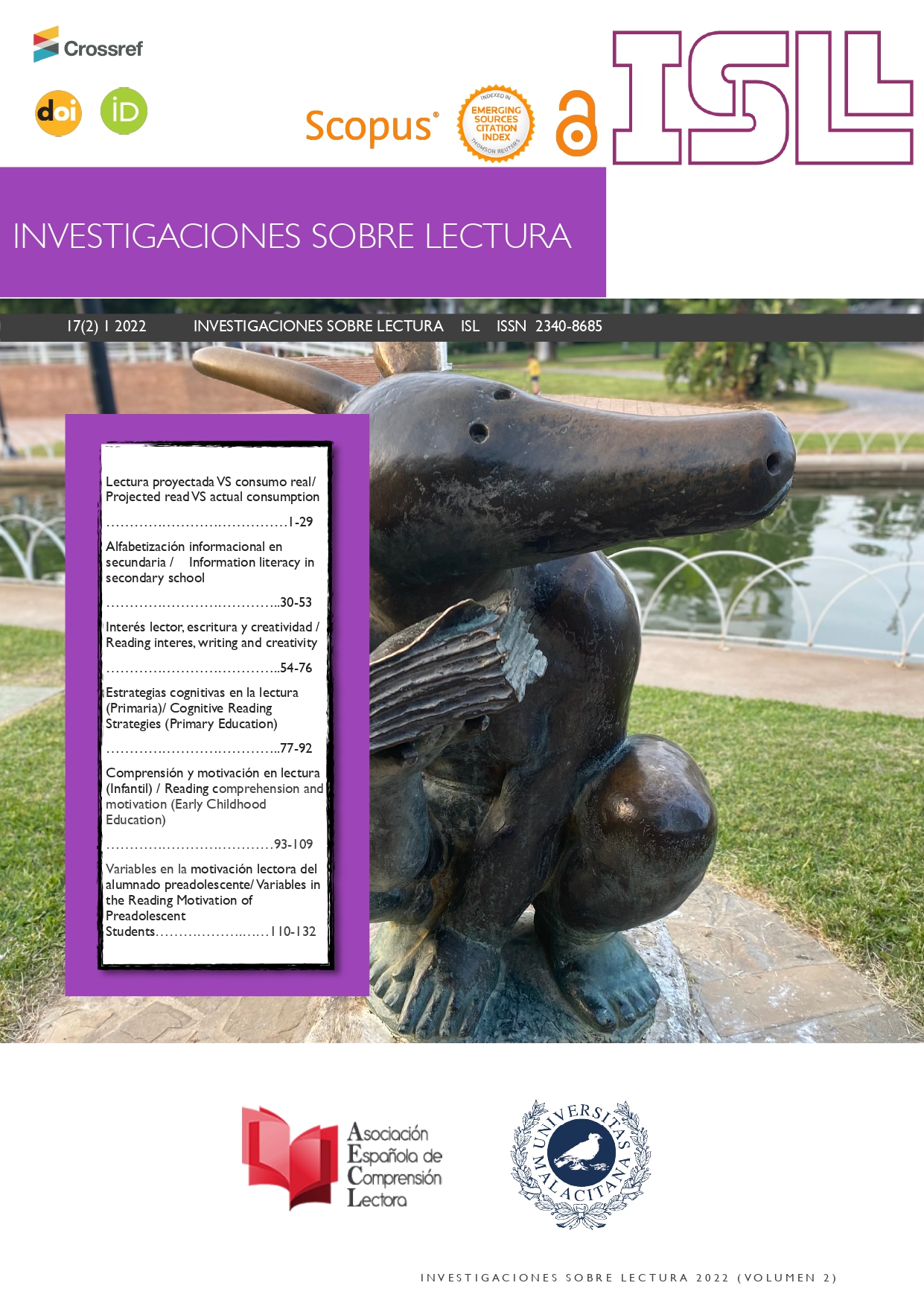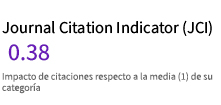El interés lector y el fomento de la escritura y de la creatividad en Secundaria y Bachillerato a través de la hiperficción narrativa
DOI:
https://doi.org/10.24310/isl.vi18.15142Keywords:
Hypertext, Creativity, ICT, Reading Interest, WritingAbstract
This article analyzes the impact that the elaboration of a narrative hyperfiction in the classroom has on reading interest, creativity, and the promotion of writing in secondary and high school students. For this purpose, six control groups and six experimental groups were formed: the former wrote a story in a word processor; the latter, a hyper-story in social networks, following a hyperfiction model proposed by their teachers. From their work and a series of subsequent tests, it was possible to determine to what extent they improved certain basic skills and competencies in the subject of Spanish Language and Literature: reading comprehension, reading motivation, creativity, written expression, and communicative competence.
Downloads
Metrics
References
Afflerbach, P., & Cho, B. Y. (2008). Identifying and describing constructively responsive comprehension strategies in new and traditional forms of reading. In S. Israel & G. Duffy (eds.), Handbook of reading comprehension research (pp. 69-90). Erlbaum. https://cutt.ly/bJz2q48
Amo, J. M. de (2015). Estructura hipertextual en la metaficción actual: proyección en la educación literaria. En J. M. de Amo, O. Cleger y A. Mendoze (eds.), Redes hipertextuales en el aula: Literatura, hipertextos y cultura digital (pp. 145-167). Octaedro.
Atzenbeck, C., & Cheong, J. (2021). International Teaching and Research in Hypertext. In Proceedings of the 32nd ACM Conference on Hypertext and Social Media (pp. 271-276). doi: https://doi.org/10.1145/3465336.3475124
Investigaciones Sobre Lectura (ISL) | 2022
Contribución de los autores: Conceptualización; metodología; análisis estadístico; investigación; preparación del manuscrito; revisión y edición.
Fondos: Investigación sin financiación externa.
Agradecimientos: A los alumnos, por su trabajo.
Beatriz Araceli Moreira Macías, Arturo Damián Rodríguez Zambrano y Tannia Aytamira Chávez Córdova (2020): Lectura digital y de textos impresos: ¿Realmente existen diferencias? Revista Caribeña de Ciencias Sociales, octubre 2020. https://www.eumed.net/rev/caribe/2020/10/lectura-digital.html
Borrás, L. (2015). La fuerza de las redes: reflexiones didácticas sobre el uso de las redes (Facebook y Twitter) y las TIC en la docencia. En J. M. del Amo Sánchez-Fortún, O. Cleger y A. Mendoza Fillola (eds.), Redes hipertextuales en el aula. Literatura, hipertexto y cultura digital (pp. 35-52). Octaedro.
Broullón-Lozano, M. A., y Romero-Santos, J. M. (2020). Hiperficción constructiva en el tercer entorno. Arbor, 196(798), a582. doi: https://doi.org/10.3989/arbor.2020.798n4006
Cantero-Sandoval, M. A., y Morales-Moreno, J. E. (2018). Cómo leer y estudiar a los clásicos con las TIC. Síntesis.
Coiro, J. (2011). Predicting Reading Comprehension on the Internet: Contributions of Offline Reading Skills, Online Reading Skills, and Prior Knowledge. Journal of Literacy Research, 43(4), 352-392. doi: https://doi.org/10.1177/1086296X11421979
Congreso de España (2020, 29 de diciembre). Ley 3. Por la cual se modifica la Ley Orgánica 2/2006, de 3 de mayo, de Educación. Boletín Oficial del Estado 340. https://www.boe.es/eli/es/lo/2020/12/29/3
Contreras, E. (2016). Los clásicos de la literatura juvenil en la formación literaria de los alumnos de Secundaria. En C. Romea Castro, S. Muñoz Gordillo y M. A. Herrero Gómez (eds.), Propuestas y experiencias sobre estructuras hipertextuales literarias en el aula (pp. 147-156). Octaedro.
Fibla, S. H. (2021). La creación de relatos digitales no lineales como herramienta intercultural en el ámbito de la filología francesa. In Anales de Filología Francesa, 29, 311-333. doi: https://doi.org/10.6018/analesff.480531
García-Roca, A. (2021). Los creepypasta como textualidades metaficcionales: oportunidades formativas para la alfabetización mediática e informacional. Tonos digital, 40(0). http://www.tonosdigital.es/ojs/index.php/tonos/article/viewArticle/2715
Gomes, L. F. (2021). Hipertexto revisitado. Novas perspectivas para pesquisa e ensino. Clube de Autores.
Guerrero, S. (2021). Del hipertexto a la hiperaula. Revista Ventanales, 17, 90-91. https://es.calameo.com/read/0063961960e71a93b3750
Henao, O. & Ramírez S. D. (2006). Impacto de una experiencia de producción textual mediada por tecnologías de información y comunicación en las nociones sobre el valor epistémico de la escritura. Revista Educación y Pedagogía, 18(46), 223-238. https://revistas.udea.edu.co/index.php/revistaeyp/article/view/6959
Herrero, M. A., y Romea Castro, C. (2016). La verdad sobre el caso Savolta: novela de Eduardo Mendoza, película de Antonio Dovre. En C. Romea Castro, S. Muñoz Gordillo y M. A. Herrero Gómez (eds.), Propuestas y experiencias sobre estructuras hipertextuales literarias en el aula (pp. 77-90). Octaedro.
Horacio (1777): Epístola a los pisones. En T. Iriarte (ed.), El arte poética de Horacio. Imprenta Real de la Gazeta.
Kirkpatrick, L. C. & Klein, P. D. (2016). High-achieving High School students' strategies for writing from Internet-based sources of information. Journal of Writing Research,8(1), 1-47. doi: https://doi.org/10.17239/jowr-2016.08.01.01
Landow, G. P. H. (1995). Hipertexto. La convergencia de la teoría crítica contemporánea y la tecnología. Paidós.
Marín-Diaz, V., y Cabero-Almenara, J. (2019). Las redes sociales en educación: desde la innovación a la investigación educativa. RIED. Revista Iberoamericana de Educación a Distancia, 22(2), pp. 25-33. doi: http://dx.doi.org/10.5944/ried.22.2.2424
Mousa, A. (2021). The digital literacy in the 21st century. Dirasat: Human and Social Sciences, 48(4), 478-483.
Muñoz, S. (2016). Jugando a ser críticos literarios: elaboración de una edición crítica en hipertexto de Penélope y las doce criadas, de Margaret Atwood. En C. Romea Castro, S. Muñoz Gordillo y M. A. Herrero Gómez (eds.), Propuestas y experiencias sobre estructuras hipertextuales literarias en el aula (pp. 59-76). Octaedro.
Nelson, T. H. (1987). Literary Machines. Edition 87.1. https://vdoc.pub/download/literary-machines-v1bif4ig7f00
Pajares, S. (1997). Las posibilidades de la narrativa hipertextual. Espéculo, 6. https://webs.ucm.es/info/especulo/numero6/s_pajare.htm
Pajares, S. (2014). Hipertexto y literatura: nuevas perspectivas didácticas. En Arbonés, C., Prats-Ripoll, M., Sanahuja, E., Cleger, O., y Amo, J. M. D. (coords. y eds.). La educación literaria y la e-literatura desde la minificción. Enfoques hipertextuales para el aula. Instituto de Ciencias de la Educación – Universidad de Barcelona (pp. 43-57). http://hdl.handle.net/2445/67641
Palau Sampio, D., & Sánchez García, P. (2020). Digital resources in the current journalistic narrative: Uses and limitations of hypertext, multimedia and interactivity. Comunicación y Sociedad, 33(2), 1-16. doi: https://doi.org/10.15581/003.33.2.1-16
Peinado, A. (2014). La lectura de reescrituras e-literarias en secundaria. En C. Arbonés, M. Prats-Ripoll, E. Sanahuja, O. Cleger y J. M. de Amo (coords. y eds.), La educación literaria y la e-literatura desde la minificción. Enfoques hipertextuales para el aula. Instituto de Ciencias de la Educación – Universidad de Barcelona, pp. 107-125. http://hdl.handle.net/2445/67641
Peinado, F., Gervas, P., y Moreno-Ger, P. (2005). Interactive Storytelling in Educational Environments. In 3rd International Conference on Multimedia and ICT´s in Education, Badajoz, España. Recent Research Developments in Learning Technologies, III, 1345-1349. FORMATEX. www.fdi.ucm.es/profesor/fpeinado/publications/2005-peinado-interactive.pdf
Peronard, M. (2007). Lectura en papel y en pantalla de computador. Revista Signos, 40(63), 179-195. doi: http://dx.doi.org/10.4067/S0718-09342007000100009
Pilar Jiménez, E., Alarcón, R., y de Vicente-Yague, M. I. (2019). Intervención lectora: correlación entre la inteligencia emocional y la competencia lectora en el alumnado de bachillerato. Revista de Psicodidáctica, 24(1), 24-30. doi: https://doi.org/10.1016/j.psicod.2018.10.001
Ramírez, L. M., y Konstantinova, L. (2018). Lectura de documentos en papel versus documentos digitales en universidades de Colombia y Ucrania. Revista Cubana de Educación Superior, 37(3), e4. http://scielo.sld.cu/pdf/rces/v37n3/0257-4314-rces-37-03-e4.pdf
Romero-Rodríguez, J. M., Aznar-Díaz, I., Hinojo-Lucena, F. J., y Gómez-García, G. (2021). Uso de los dispositivos móviles en educación superior: relación con el rendimiento académico y la autorregulación del aprendizaje. Revista Complutense de Educación, 32(3), 327-335. https://hdl.handle.net/11162/212489
Rovira-Collado, J., y Llorens García, R. F. (2017). Epitextos digitales como estrategia LIJ 2.0 para la formación integral en Didáctica de la Lengua y la Literatura. En R. Roig-Vila (ed.), Investigación en docencia universitaria. Diseñando el futuro a partir de la innovación educativa (pp. 733-743). Octaedro. http://hdl.handle.net/10045/71194
Silveira, A. G., Pereira, V. C., & Borges, F. G. B. (2021). O rizoma hipertextual no romance digital 253, de Geoff Ryman. REVELL: Revista de Estudos Literários da UEMS, 2(22), 107-123. https://dialnet.unirioja.es/descarga/articulo/8085183.pdf
Spires, H., & Estes, T. (2002). Reading in webbased learning environments. En C. Collins Block & M. Pressley (eds.), Comprehension instruction: Research-based best practices (pp. 115–125). Guilford Press.
Stepanchuk, Y. A. (2020). "Brain-mimicking Machine" in Digital Utopias: From Memex to Hypertext and Beyond. KnE Social Sciences, 4(5), 77–82. doi: https://doi.org/10.18502/kss.v4i5.6519
Vallejos Carrasco, G., Véliz de Vos, M., y Sáez Carrillo, K. (2021). Estructura hipertextual y habilidad lectora: Análisis de la producción digital de textos argumentativos en estudiantes de 4º Año Medio. Revista signos, 54(105), 97-119. doi: https://doi.org/10.4067/S0718-09342021000100097
Vivas, P., Torres, C., Gualteros, N., y Flechas, M. (2010). Lectura digital en jóvenes universitarios: una revisión. Revista de Psicología y Educación, 1(5), 95-108. https://hdl.handle.net/11162/221864
Yubero, S., & Larrañaga, E. (2015). Lectura y universidad: hábitos lectores de los estudiantes universitarios de España y Portugal. Profesional de la Información, 24(6), 717-723. https://cutt.ly/ozEXUvV
Downloads
Published
How to Cite
Issue
Section
License
All contents published in Investigaciones sobre la Lectura are protected under the Creative Commons Attribution-NonCommercial-ShareAlike 4.0 International (CC BY-NC-SA 4.0) license. All about this license is available in the following link: <http://creativecommons.org/licenses/by-nc-sa/4.0>
Users can copy, use, redistribute, share and exhibit publicly as long as:
- The original source and authorship of the material are cited (Journal, Publisher and URL of the work).
- It is not used for comercial purposes.
- The existence of the license and its especifications are mentioned.
There are two sets of authors’ rights: moral and property rights. Moral rights are perpetual prerogatives, unrenounceable, not-transferable, unalienable, imprescriptible and inembargable. According to authors’ rights legislation, Investigaciones sobre la Lectura recognizes and respects authors moral rights, as well as the ownership of property rights, which will be transferred to University of Malaga in open access. The property rights are referred to the benefits that are gained by the use or the dissemination of works. Investigaciones sobre la Lectura is published in an open access form and it is exclusively licenced by any means for doing or authorising distribution, dissemination, reproduction, , adaptation, translation or arrangement of works.
Authors are responsable for obtaining the necessary permission to use copyrighted images.










31.png)








